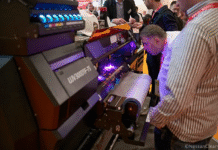One to One Creations, based in the bustling economic hub of Dharavi, offers print solutions to garment manufacturers with manufacturing units in the area. It prints photos for kidswear makers who use those photos as identifiers or promotional tools on their packages. The company recently installed an HRL 14 thermal lamination machine from Hi-Tech Systems. The thermal lamination machine is used to enhance the prints it produces on a Konica Minolta digital press.
“The photos that we print on the Konica Minolta digital press go to the thermal lamination machine that has been provided by Hi-Tech. The prints get the required gloss and their attractiveness at the point of sale is enhanced. This is essential because our customers demand high gloss images as they use these photos on their packaging for supply to their customers,” says Pradeep Sunku who manages the operations along with his brother Arun Sunki.

Since One to One Creations services only kids wear manufacturers, the photos that it prints are of kids in the variety of garments produced by the manufacturers in the surrounding areas. While Pradeep Sunku looks after the printing and designing, Arun Sunki looks after the photography department. One to One Creations offers photography or portfolio creation, designing, and printing services under one roof. The three-year-old company employs 12 people.
Sunku says the company went in for the new lamination machine as the older one was manual and required intensive manpower. “Because the HRL 14 lamination machine has an automatic feeder and cutter, the productivity is much higher than the laminator we had before. This saves not only manpower but also electricity cost. There has been a big reduction in wastage as we are already laminating about 1,400 copies daily, although the maximum capacity of the machine is 2,000 copies per day. We will ramp up gradually,” Sunku says.
In addition to the Konica Minolta digital press, One to One Creations also operates one from Noritsu. On the Konica Minolta press, the company prints about 1400 impressions of 12X18-inches stock every day while on the Noritsu, it prints about 2,000 impressions of 8X10-inch sheets.
Business back to normal
Business at One to One Creations was disrupted only during the first phase of the lockdown in 2020. In the second wave of the pandemic, things were mostly normal and the Omicron wave did not have any impact on the company’s business.
“Since we service a very specific set of customers, that is kids wear manufacturers, we were not impacted much in the second and the third wave. Yes, the first lockdown was national so we were closed for three months. Currently, our business has returned to normal. We expect things to be good going forward as shopping for kids wear ahead of the Eid festival has been very good,” Sunku concludes.
















